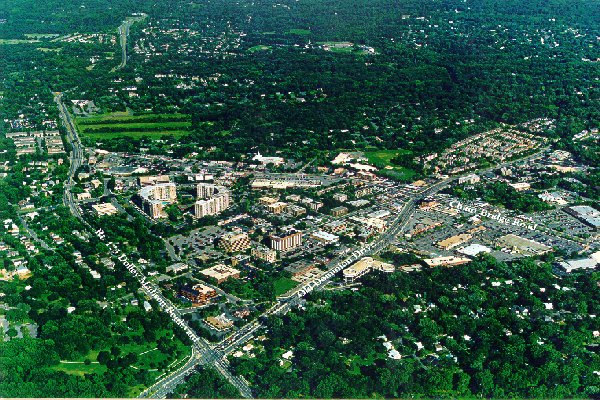

More or less.
In this aerial photo, which is facing East, the Potomac is even farther East, flowing left to right across the top of your monitor. My house, were it included, would be about six inches to the right of the area shown, at roughly three o'clock. Evidently, the McLean, VA Chamber of Commerce, who took this picture, had other priorities. De gustibus non est disputandum.
I arrived in McLean at the beginning of 1980. My new position was with The MITRE Corporation, a not-for-profit organization referred to, in those days, as a "think tank" and less than a ten-minute walk from my condo. My new assignment was, of course, in the field of chemistry. Specifically, I was to help review applications made by industry to the Environmental Protection Agency (EPA) for the production of substances that had never before been sold in large quantities. The concern was that some of them might be toxic and there was a law stating that all must therefore be approved before manufacture.
I can be very patient at times and it took me three years to get tired of this. In 1984, I returned to graduate school, part time, at George Washington University. On this occasion, I switched fields entirely by studying computer science, specializing in Machine Learning, a branch of AI. I did not want to attempt another Ph.D. while only a part-time student so I settled for a non-thesis version of the same -- an Ap.Sc. (Applied Scientist) degree. This is a demanding program comprising a really huge number of course credits plus a lot of research. My research was in the area of Collective Learning Systems/Automata. I finished in 1987 with a degree in Computer Heuristics, Modeling and Numerical Methods. Sounds impressive, doesn't it?
Needless to say, Artificial Intelligence is of limited utility in scrutinizing the manufacture of photoresists, solvents, and self-developing film, etc. Consequently, I also switched divisions and set to work, instead, analyzing requirements for the future Air Traffic Control system of the United States. This work was, and is, continually sponsored by the Federal Aviation Aministration (FAA).
Of all the projects that I have worked on since moving over to CAASD, the FAA side of the house, perhaps the most significant is the Traffic Alert and Collision Avoidance System, TCAS. Basically, this is an airborne avionics system to help prevent air-to-air collisions. It works. My job, for many years, was to prove that it worked—without experimenting on the flying public. These studies were therefore accomplished using fast-time, Monte Carlo simulations. Here, as principal investigator for TCAS safety, my computer expertise was put to good use.
Currently, and for the past several years, I have been working to improve the Wide-area Augmentation System (WAAS) of the Global Positioning System (GPS). This again involves software simulations, mathematical modeling and statistics. Quite a change from organic chemistry!
These days, I spend nearly all my time with computers in one fashion or another, especially if they are Macintosh™ computers. Most of my spare time, as well, is devoted to software development with an emphasis on statistics, numerical methods and optimization. The rest is spent reading and writing. However, I have not forgotten my roots, as the remainder of this site should illustrate.
Like this website, my life, career, etc. remain under construction.
Come back and see me sometime!